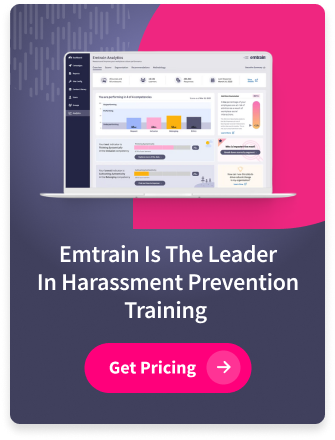Using Harassment Prevention Training as a Tool to Cultivate Workplace Respect
In 2019, companies went from delivering 2 hours of harassment prevention training every other year to their managers in California, to delivering training every year to their entire U.S.workforce. In other words, the amount of time and resources allocated to a harassment and respect program for managers and employees has ballooned in the last six (6) years.
And yet, other than leaning into online training, most companies have not rethought their strategy for this respect training program even though the scope, cost, burden and impact on the company has drastically increased. It’s a missed opportunity. Given the amount of time and money devoted to these programs, companies should get at least three (3) things from them:
- Showing current workplace dynamics.
- Developing culture skills to reduce disrespect, conflict and claims.
- A legal warranty of compliance and practicing lawyers on hand to advise on regulations and best practice.
Showing current workplace dynamics
Now that everyone is sponsoring annual harassment prevention training to their entire U.S. workforce, doesn’t it make sense to use this program as an annual Employee Relations course and discuss the current workforce dynamics and behaviors that people struggle to navigate? If you’re going to take up peoples’ time – shouldn’t the content be relevant and helpful to them? If so, you need new content every year to show the most current issues.
Whether you’re using video scenes, animations or cartoons to show what these issues look like, you need fresh content each year for it to be helpful. Emtrain’s content team interviews clients all year round and shoots video scenes based on issues that clients tell them about.
Last year, clients across the board shared their struggles with:
- Mental health issues and employees increasingly taking leaves of absence
- Employees feeling increasingly comfortable to say whatever is on their mind – without filters – because they think they’re protected by the First Amendment
- Multi–generational differences and the conflicts stemming from those differences
- Disrespectful assumptions about privilege due to race, and many others.
Your employees should be able to see the situations they know are causing friction and conflict on teams, see how people think about those issues, and see best practice for how to navigate those issues. If you’re not showing new video scenes of current events each year to your workforce, you’re missing a big opportunity to use the annual respect program to address employee relations within your workforce.
Developing culture skills to reduce disrespect, conflict and claims
Legal regulations prompt companies to communicate and socialize their harassment prevention policies and that’s what companies have been doing for years. That was fine when the commitment to respect training programs was minimal. It’s not minimal anymore and yet companies are still largely thinking of their training programs as a communication tool for their harassment prevention program. That’s a big missed opportunity.
Let’s face it. We all know it takes skill to nurture relationships and navigate people with all of their idiosyncrasies. Ask any employment lawyer and/or employee relations expert and they will tell you that only a very small percentage of claims about harassment and discrimination are legal issues. Most of these claims are about people struggling to communicate and interact with each other in a productive, respectful manner.
As we work with people from different racial, cultural, and generational backgrounds, misunderstandings and conflicts are inevitable—but they don’t have to derail the workplace. Companies should view annual respect training as an opportunity to teach practical skills for navigating differences. When employees learn how to communicate effectively, address unconscious biases, and resolve conflicts respectfully, the workplace becomes a more inclusive and productive environment.
When done with intention, respect training addresses both cultural skill gaps and legal compliance. It equips employees with tools to handle the realities of modern workplace dynamics. This means offering fresh, relevant content every year, showing employees how to manage today’s challenges, and building confidence in their ability to engage respectfully and thoughtfully with colleagues.
Ultimately, companies have an opportunity to make annual respect and harassment prevention training more than just a checkbox. By prioritizing meaningful–and fresh–content and focusing on skills that reduce conflict and improve relationships, organizations can turn this mandatory program into a powerful tool for creating stronger teams and a healthier workplace culture. If you’re investing the time and resources, make it count—training can and should go beyond compliance to drive real, measurable improvements.








